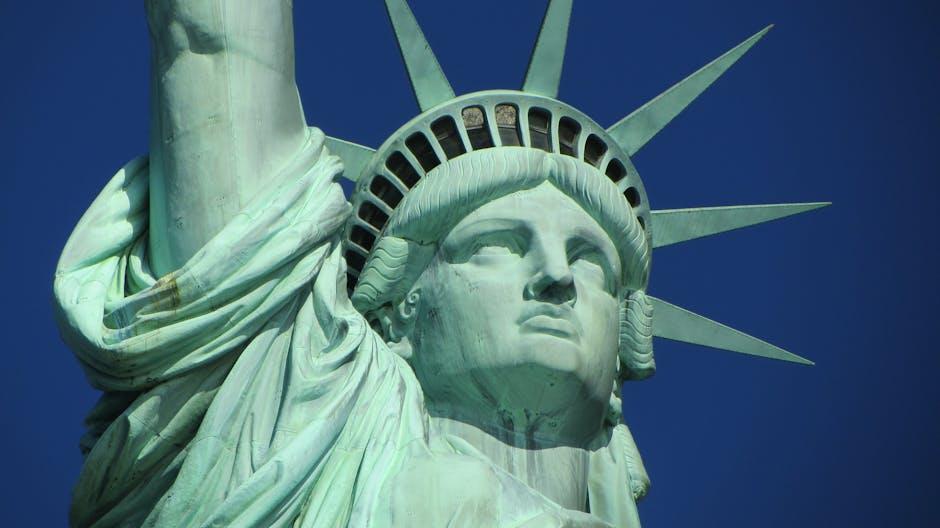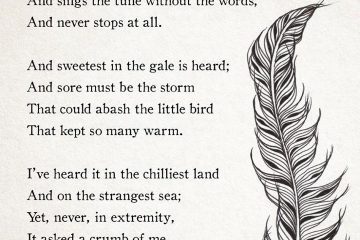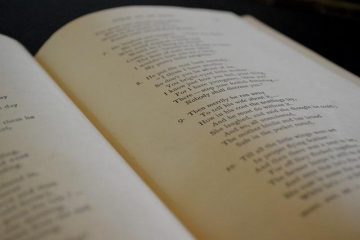Table of Contents
- Exploring the Symbolism of the Poem at the Statue of Liberty
- Unpacking the Historical Context of the Poem
- Literary Analysis of Emma Lazarus Influence
- Visiting the Statue of Liberty: A Guide to Understanding the Poem
- Promoting Awareness: How the Poem Resonates Today
- Q&A
- In Retrospect
Exploring the Symbolism of the Poem at the Statue of Liberty
At the foot of the majestic Statue of Liberty, a poignant poem by Emma Lazarus resonates with the ideals of freedom and opportunity. The lines encapsulate the spirit of inclusivity, welcoming immigrants yearning for a better life. Through metaphor and vivid imagery, Lazarus’s work represents the embrace of hope and the relentless pursuit of dreams. It serves as a powerful reminder that the United States has historically positioned itself as a sanctuary for those fleeing oppression and hardship, intricately weaving their ambitions into the fabric of the nation.
The poem’s symbolism extends beyond mere words, reflecting universal themes such as liberty, acceptance, and resilience. For instance, the phrase “Give me your tired, your poor” evokes a sense of compassion and solidarity with those who face adversity. The use of light imagery, particularly in the context of Lady Liberty herself, signifies a guiding force that shines a beacon of hope amidst despair. This powerful contrast between darkness and light underscores the transitional journey of individuals arriving in a new land filled with promise.
| Symbol | Meaning |
|---|---|
| Statue of Liberty | Freedom and Democracy |
| Light | Hope and Guidance |
| Open Arms | Welcoming of Immigrants |
| Poem | Expression of Unity |
Ultimately, the poem emblazoned at the base of the Statue of Liberty transcends its historical context, remaining relevant in today’s societal narratives surrounding immigration and the American dream. It challenges us to reflect on our values and our collective responsibility to uphold them. By honoring the sentiments expressed in Lazarus’s words, we not only pay homage to our past but also reaffirm our commitment to building a future where diversity and inclusion are celebrated as strengths, paving the way for a richer, more vibrant society.


Unpacking the Historical Context of the Poem
The poem inscribed on the pedestal of the Statue of Liberty, “The New Colossus” by Emma Lazarus, emerged during a pivotal era in American history. Written in 1883, the poem reflects the sentiments of a nation welcoming waves of immigrants seeking refuge from oppression and poverty. At that time, the United States was experiencing a significant influx of immigrants, particularly from southern and eastern Europe, driven by the promise of opportunity and the allure of the American Dream. This poem, contrasting the oppressive Colossus of ancient Rhodes with Lady Liberty, serves as a beacon of hope and rebirth for the millions arriving on New York’s shores.
The historical landscape of the late 19th century was marked by intense social change and industrial growth. Cities expanded rapidly, and the rise of factories drew many people from rural areas, both domestically and abroad. As new immigrants arrived, they faced challenges such as poverty, discrimination, and the struggle for labor rights. The poem encapsulates this struggle, positioning the Statue of Liberty not just as a monument but as a symbol of welcome and a sanctuary for the weary, echoing the aspirations and dreams of countless individuals who sought a better life.
Moreover, Lazarus’s work contributed to the broader dialogue about American identity and values. The poem’s closing lines, which invite the tired and the poor to come, highlight the transformative power of compassion and inclusion. This narrative was crucial, especially during a time when nativism and xenophobia were on the rise. The juxtaposition of the Statue of Liberty with the poem reinforces the idea that America is not solely defined by its land or resources, but by the diverse individuals who contribute to its legacy. By examining the historical context, one can better understand how this poem continues to resonate today, reflecting ongoing debates about immigration and identity in modern America.


Literary Analysis of Emma Lazarus Influence
Emma Lazarus’s poem “The New Colossus” profoundly shapes America’s cultural landscape, particularly through its association with the Statue of Liberty. This sonnet, written in 1883, serves not only as an artistic expression but also as a rallying cry for immigrants arriving on American shores. Lazarus’s words, notably the famous lines “Give me your tired, your poor, your huddled masses yearning to breathe free,” have become emblematic of the United States’ identity as a refuge for those seeking opportunity and freedom. By portraying the statue as a welcoming mother, she reinforces the idea of America as a land of asylum and hope.
The poem’s influence extends beyond its immediate context, resonating through the ages as a testament to American values. The characterization of the Statue of Liberty as a “mighty woman” marked a crucial shift in the national narrative, emphasizing empathy and inclusiveness rather than merely showcasing power. This transformation can be seen as a reflection of broader societal changes regarding immigration and identity. Lazarus’s work calls into question the prevailing notions of separation and exclusivity, urging a reconsideration of what it means to belong in America.
In embedding her themes of compassion and acceptance within the framework of the statue, Lazarus connects poetry and politics. The enduring legacy of her work highlights the potential of art to foster dialogue about national identity and social justice. By analyzing the impact of “The New Colossus,” one can appreciate how literature not only encapsulates but also shapes the historical and cultural discourse of its time. This interplay between art and societal values continues to be relevant, as modern discussions around immigration and inclusion reflect the ideals originally articulated by Lazarus.


Visiting the Statue of Liberty: A Guide to Understanding the Poem
The Statue of Liberty, a symbol of hope and freedom, is enriched by the powerful words of the poem “The New Colossus,” written by Emma Lazarus. Inscribed on a bronze plaque within the statue’s pedestal, the poem captures the essence of what liberty represents for immigrants arriving on American shores. It describes the statue not just as a stunning piece of art but as a welcoming figure, beckoning the tired and the poor yearning to breathe free. This greeting sets the tone for understanding the profound impact the statue has on those who arrive, often with dreams of a better life.
One of the most poignant lines illustrates the statue’s role as a ”Mother of Exiles.” This phrase emphasizes the nurturing qualities of Lady Liberty, portraying her as a protective figure for those who find themselves in pursuit of refuge from oppression. The poem contrasts the grandeur of the statue itself with the struggles faced by immigrants, highlighting themes of resilience and hope. Key themes to consider when reflecting on this iconic work include:
- Hope: The poem symbolizes the aspirations of individuals seeking a new beginning.
- Welcoming Spirit: The statue’s outstretched torch invites those in need of safety.
- Struggle: It acknowledges the hardships faced by immigrants on their journey.
An examination of the historical context reveals how Lazarus’s words resonate beyond the late 19th century. The poem emerged during a time when the United States was solidifying its identity as a refuge for the oppressed. Understanding this connection enhances the visitor’s experience, making it more than just a sightseeing opportunity. As you gaze upon the statue, consider what her message means today, especially as it relates to current global issues of migration and asylum. Reflecting on these elements encourages deeper engagement with both the statue and the ideals of freedom it embodies.


Promoting Awareness: How the Poem Resonates Today
The essence of the Statue of Liberty transcends its physical presence, echoing an enduring call for freedom and acceptance in our contemporary world. The poem inscribed on its pedestal serves not only as a historical marker but also as a universal message relevant to today’s societal struggles. As nations grapple with issues of immigration, refugee crises, and human rights, the sentiments captured in the poem remind us of the values of hope and unity that are integral to the human experience. These lines resonate deeply, urging us to foster inclusivity and empathy towards those seeking a better life.
Moreover, the imagery painted in the poem evokes powerful emotions that align with current movements advocating for change. The invitation to the ‘huddled masses’ symbolizes the welcoming of diverse cultures, pushing us to reflect on our collective identity and responsibilities. In a time when division is prevalent, the message encourages dialogue and understanding, promoting a narrative that celebrates differences rather than perpetuates stereotypes. This call to arms not only resonates with individuals but also inspires communities and organizations to embody the spirit of charity and acceptance in their actions.
| Theme | Relevance Today |
|---|---|
| Freedom | Continued fights for civil rights globally |
| Unity | Collective action in social justice movements |
| Hope | Inspiration for marginalized communities |
Ultimately, the poem is more than just a timeless literary piece; it acts as a beacon of hope and a reminder of the values upon which societies thrive. As we navigate today’s complexities, it beckons us to renew our commitment to the ideals of liberty and compassion, ensuring that the legacy of the Statue of Liberty remains alive in our hearts and actions. From supporting human rights initiatives to engaging in conversations about inclusion, the poem serves as a catalyst, pushing us towards a future where the principles it embodies continue to flourish in our global society.
Q&A
Q&A: The Poem Behind the Statue of Liberty
Q1: What is the famous poem associated with the Statue of Liberty? A1: The poem famously associated with the Statue of Liberty is “The New Colossus,” written by Emma Lazarus in 1883. This sonnet, inscribed on a plaque inside the pedestal of the statue, encapsulates the spirit of welcoming immigrants to America, portraying the statue as a “Mother of Exiles.”Q2: What themes does “The New Colossus” explore? A2: “The New Colossus” explores themes of refuge, hope, and the immigrant experience. It contrasts the statue with the ancient Colossus of Rhodes, emphasizing the Statue of Liberty as a symbol of liberation and opportunity, inviting those longing for a better life to find solace in America.
Q3: Why is Emma Lazarus’s poem significant in American history? A3: Emma Lazarus’s poem is significant because it framed the Statue of Liberty as a beacon for immigrants seeking a new home. During a time when America was grappling with its identity, Lazarus’s words provided a powerful message of inclusivity and compassion, shaping how the nation views its role as a refuge for those in need.
Q4: How did the poem influence public perception of the Statue of Liberty? A4: The poem influenced public perception by transforming the Statue of Liberty from a mere monument to a symbol of hope and acceptance. Lazarus’s words helped define the statue’s mission—serving as a reminder of America’s heritage as a nation of immigrants and its ongoing duty to welcome the “huddled masses yearning to breathe free.”
Q5: Is “The New Colossus” still relevant today? A5: Yes, “The New Colossus” remains profoundly relevant today, as issues surrounding immigration, human rights, and national identity continue to resonate. The poem’s call for compassion and welcome is echoed in contemporary discussions about how nations embrace or reject newcomers, making it a timeless reminder of the values America was built upon.
Q6: Where can people find the poem today? A6: The poem is inscribed on a bronze plaque located in the pedestal of the Statue of Liberty. Visitors can read it during their trip to Liberty Island, and it is widely published in various collections of Lazarus’s work, appearing in books, online resources, and educational materials focusing on American history and immigration.
Q7: How can educators use “The New Colossus” in the classroom? A7: Educators can use “The New Colossus” as a starting point for discussions on immigration, identity, and American values. Activities can include analyzing the poem’s language, comparing it to current immigration policies, or encouraging students to write their own verses reflecting their understanding of freedom and opportunity.
By shedding light on these questions, we can better appreciate the profound impact of Emma Lazarus’s poem and its enduring legacy as part of the Statue of Liberty’s significance.




0 Comments